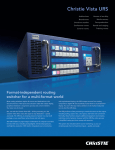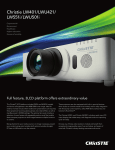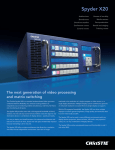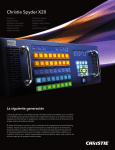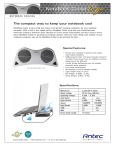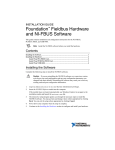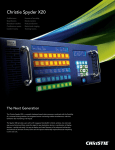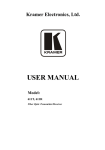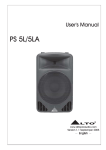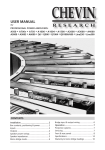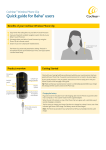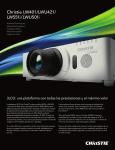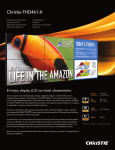Download 1 PDF Manual Spyder X20-0808 by Christie Digital
Transcript
Christie Spyder X20 Auditoriums Houses of worship Boardrooms Media centers Broadcast studios Post-production Conference rooms Rental and staging Control rooms Training rooms The Next Generation The Christie Spyder X20 is a versatile hardware-based video processor combined with the flexibility of a universal routing switcher. Its integrated source monitoring enables simultaneous, real-time, full frame rate monitoring of all inputs. The Spyder X20 provides users with a 20 megapixel bandwidth to blend, window, mix and scale any source format and then routes the signal to any destination device or combination of display devices – quickly and easily. It is easy to deploy and install because of its advanced architecture and reduces the amount of wires, boxes and rack space traditionally required because everything is all in one unit. CHRISTIE SPYDER X20 Christie Spyder X20 The next generation of video processing and matrix switching The Spyder X20 offers a unique architecture that allows for a resolution and video format-independent environment. Users are no longer restricted to the resolution of a single computer or video source, or a single display destination. Multiple displays can be combined to generate an enhanced resolution to exceed what any single display can support. Ideal for live event and broadcast environments, its 20 megapixel bandwidth enables the Spyder X20 to drive multiple displays to achieve greater brightness, image quality and resolution than has been historically possible. The Spyder X20 can be used in many different environments with any display device (projectors, plasma screens, LED walls, rear projection cubes, etc.) or any combination of display devices. The Spyder X20 provides unsurpassed power and functionality in only 4 rack units (4RU). This generation of Spyder The Spyder X20 is designed for users in any environment to take images from unique sources, use a variety of display systems and present the images as intended. It is ideal for applications such as live events, broadcast, high-end boardrooms, command and control, houses of worship and education – any installation that has multiwindowing, multiple displays and processing requirements. The Spyder X20 also offers the flexibility to display 2D and 3D content simultaneously in the same display. Software interface The Microsoft® Windows based control software provides full set-up, configuration, and real-time control with an easy-to-use interface. Key features 0 megapixel bandwidth 2 Internal matrix switching Universal input/output capabilities – mix and match multiple formats with one piece of equipment Input capability – either 8 or 16 inputs (depending on model) that can be a mix of analog BNC and DVI signals Output capability – 8 outputs that natively support any display from component analog 480i to digital 4K Built-in conversion for analog/digital, interlaced/progressive, resolution, aspect ratio and refresh rate 2D and 3D capabilities Manages and displays multiple 3D sources Define properties for each output independent of each signal Integrated source monitoring – real-time and full frame rate view of all sources connected to the Spyder X20 (either 16 or 8 inputs) on a single output, tiled into either a 4x4 array (X20-1608) or a 4x2 array (X20-0808) Single point of control for all processing and signal distribution functions from front panel, PC via Ethernet, or external control system 10-bit processing Small form factor – (LxWxH): 21.9 x 17.3 x 7.0" (556 x 439 x 178mm). Additionally, only one piece of equipment is required so the overall space used in a rack is reduced Each output individually supports rotation – enabling the creation of vertically-oriented displays User-definable edge blending and tiling Create any kind of window border or drop shadow with adjustable color, width, softness, shadow offset and transparency Online editing mode allows for preset displays to be built and edited in preview mode without affecting what the audience is seeing Additional features Built-inimage Still Store functionality Built in VESA calculator for custom resolution outputs Intuitive graphical user interface (GUI) Simple cohesive control of all functions Redundant hot swappable power supplies Optional stereoscopic support Advanced auto-sync functionality Bitmap borders Window titling Optional HDCP support Vista Advanced is a Windows-based software interface that makes it easy to configure and control the Spyder X20. Bitmap borders 1 Reduced rack space CHRISTIE SPYDER X20 Front panel With the Spyder X20, layers can be in ‘program’ and in ‘preview’ mode. You can build preset displays in preview mode using live layers without affecting the display being viewed by the audience. Spyder X20-0808 rear panel The Spyder X20-0808 has 8 inputs and 8 outputs, and is easy to use and configure. Spyder X20-1608 rear panel The Spyder X20-1608 has 16 inputs and 8 outputs, that can be a mix of analog BNC and DVI signals. Minimum PC requirements Input Output Spyder X20-0808 Spyder X20-1608 8 inputs • 4 supporting composite, S-video, component analog, HDSDI, SDI, and 3G SDI (SMPTE 424M) • 4 supporting progressive DVI and progressive RGBHV • 16 inputs • 8 supporting composite, S-video, component analog, HDSDI, SDI, and 3G SDI (SMPTE 424M) • 8 supporting progressive DVI and progressive RGBHV number • signals • Analog RGB composite, component • DVI, single-link and dual-link (8 inputs are dual-link capable) • SDI, HD-SDI and 3G-SDI (SMPTE 424M) pixel clock • Analog up to 165 MHz • DVI up to 330 MHz resolutions • orizontal resolutions up to 2560 and vertical resolutions up to 2160 H within 330 MHz (any resolution greater than 2048 x 1200 uses 2 input channels) scan rates • Up to 120Hz dependant on pixel clock rate maximum number • @ (< 2048 x 1200) or 4 @ (2560 x 1600) or a combination of 4 dual-link 8 and 4 single-link resolutions signals • Analog RGB, component • DVI, single-link and dual-link (4 outputs are dual-link capable) • SDI, HD-SDI and 3G-SDI (SMPTE 424M) pixel clock • Analog up to 165 MHz • DVI up to 330 MHz resolutions • orizontal resolutions up to 2560 and vertical resolutions up to 2160 H within 330 MHz scan rates • Up to 120Hz dependant on pixel clock rate maximum Control and networking • RS-232 in/out • Ethernet (10/100/1000) Enhanced feature sets Independent aspect ratio and frame rate set-up • Overlays • Transitions • Aspect ratio conversions • Integrated source monitoring • Output rotation (portrait) • Optional stereoscopic support • Optional HDCP support • 2D and 3D capabilities Accessories • • • User manual (CD-ROM) • 2 AC power cords Vista Advanced 2009 software • Rack hardware operating voltage • 100-240 VAC @ 50/60Hz operating current • 9.0A @ 100 VAC power • 900W dissipation • <750 BTU/hr space requirements • 4RU size • (LxWxH): 21.9 x 17.3 x 7.0" (556 x 439 x 178mm) shipping size • (LxWxH): 32.3 x 25.5 x 15.0" (820 x 648 x 381mm) volume • 2652in3 weight • 59lbs (27kg) shipping weight • 70.5lbs (32kg) Operating environment • Temperature: 40-95°F (5-35°C) • Humidity: 20-80% non-condensing Regulatory approvals • Limited warranty • Power requirements Dimensions standard his product conforms to the following regulations related to product T safety, environmental requirements and electromagnetic compatibility (EMC): • UL/CSA/IEC 60950 (3rd edition) • FCC Class A, CE, CCC • RoHS, WEEE • 1 year parts and labor ontact an authorized Christie representative for full details of our limited C warranty Microsoft Windows® 7 Based Computers Microsoft’s Windows® 7 platform provides a rating called the ‘Windows Experience Index’, which measures the capability of your computer’s hardware and software configuration and expresses this measurement as a number called a base score. A higher base score generally means that your computer will perform better and faster than a computer with a lower base score, and makes it simple to purchase a PC with confidence that it will work properly with the Vista Advanced software interface. Requirements ‘Windows Experience Index’ of 4.0 or greater Microsoft Windows XP Based Computers Computers running the Windows XP user interface do not support the ‘Windows Experience Index’ provided in Windows Vista and Windows® 7, and therefore the hardware profile listed below can be used as a base hardware configuration. Requirements Pentium 4, 2.5Ghz or equivalent 512MB of RAM 128MB, DirectX 9.0 compatible video card (NVidia preferred) Windows XP Professional, Service Pack 3 Microsoft .NET framework, Version 4.0 Microsoft DirectX 9.0c or later Note: MAC or PC emulators such as VMWare and Microsoft Virtual PC should not be used to run Vista Advanced; support cannot be provided for users using an emulator of any kind. 2 Corporate offices EMEA offices Christie Digital Systems USA, Inc USA – Cypress PH: 714 236 8610 United Kingdom Branch & EMEA Head Office ViewPoint 200 Ashville Way Wokingham Berkshire, U.K. RG41 2PL PH: +44 (0) 118 977 8000 Christie Digital Systems Canada Inc. Canada – Kitchener PH: 519 744 8005 Africa Branch Office PH: +27 (0)11 510 0094 Middle East Branch Office PH: +971 (0) 4 320 6688 Eastern Europe Representative Office PH: +36 (0)1 47 48 100 Spain Branch Office PH: +34 91 633 9990 France Branch Office PH: +33 (0) 1 41 21 44 04 Italy Independent Sales Consultant Office PH: +39 (0) 2 9902 1161 Germany Branch Office PH: +49 2161 664540 Russia Independent Sales Consultant Office PH: +7 (495) 930-8961 For the most current specification information, please visit www.christieemea.com Copyright 2014 Christie Digital Systems USA, Inc. All rights reserved. All brand names and product names are trademarks, registered trademarks or tradenames of their respective holders. Christie Digital Systems Canada Inc.’s management system is registered to ISO 9001 and ISO 14001. Performance specifications are typical. Due to constant research, specifications are subject to change without notice. CHRI2990_EN_JAN14




